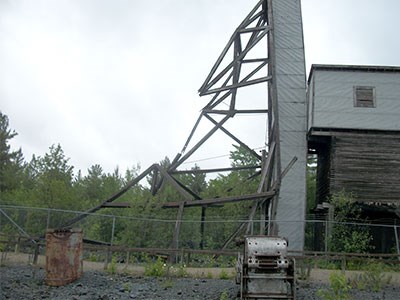Headframes are part of the iconography on which Cobalt has built its tourism industry. But a recent announcement that two of those headframes would be demolished has some worrying about the future of the town’s heritage.
In a letter circulated to stakeholders and media around the North, Nina Chamaillard laments the removal of the Nipissing #96 and Nipissing #73 headframes, announced by current property owner Agnico Eagle in December, suggesting it would negatively impact the town’s tourism industry.
“I cannot help but question, why can they not fix the stiff legs (headframe supports) and make the sites safe and leave a legacy in Cobalt,” she writes. “Viewing headframes at their actual site is what brings tourists to Cobalt and keeps our heritage alive.”
After decades of reaping the monetary benefits gleaned from mining, Chamaillard argues, companies should give back to the community by contributing to the preservation of Cobalt, which was declared a National Historic Site in 2002 for its rich history of silver mining that began in the early 1900s.
While she recognizes the ardour people have for the headframes and Cobalt’s mining legacy, Mayor Tina Sartoretto said it’s unrealistic to expect Agnico Eagle to maintain all the headframes in town. With several headframes still standing, many of them 50 and 60 years old, taking two of the most dilapidated down won’t cripple tourism in the area, she said, especially since those two aren’t unique or critical to the industry.
“We’re a small community that has not a lot of human resources or volunteers to do the kind of work that would be needed to do that, and nor are we prepared to invest the kind of money and time that it would take to do the work on those for another five, six years,” she said. “So, we just thought, hey, let’s just contain what we have and concentrate on what we can manage.”
Some of the headframes were restored 10 years ago when the town established the Heritage Silver Trail, but many of the headframes are beyond repair and on the verge of collapsing, she added.
That poses a serious safety issue, said Dale Coffin, corporate director of communications for Agnico Eagle, and the liability lies with the company.
Even though the company didn’t build the structures, as the current owner of the property’s mineral rights, it’s responsible for maintaining the property and any infrastructure, including mitigating any safety risks to the public, Coffin said. After completing its most recent review, Agnico Eagle determined the two headframes needed to come down.
But the company also recognizes the historical importance of the headframes to the town, Coffin said. That’s why, upon completion of its review last summer, the company set up consultations with the Town of Cobalt and the Cobalt Historical Society.
“We spent a lot of time with the people from the historical society understanding the value and importance of these two locations, and they helped us determine exactly what could be done in the process, which was a great help to us,” he said.
Although both headframes were set to be dismantled by the end of 2013, Agnico has pledged to preserve the hoist room of Nipissing #96, as well as a viewing gallery where visitors can see where the silver vein came to surface—both unique features of the site. The company has also committed to keep as much wood from the headframes as possible for use by the historical society in preserving other headframes in town.
Coffin said monitoring for old mining hazards is a continual process, since new, previously hidden dangers can appear as the ground shifts.
With more than 100 mine sites in the area of Cobalt and Coleman Township—not all of them belonging to Agnico Eagle—that means mining companies have to keep constant vigilance to maintain safety.
“It’s such an old mining area, with a lot of unmapped and uncharted tunnels and workings, that periodically things do open up,” he said. “So we have to go back every year and make sure there are adequate safety measures in place to make sure people don’t fall in accidentally.”
Sartoretto said Agnico Eagle has been a good corporate citizen, keeping the town informed and involving it in consultation on the demolition.
She said that, while not unimportant, the concern about the dismantling of the headframes is the view of a small minority.
“I don’t want to trivialize the passion that some people have for the headframes, but it’s like the grain elevators in the West: they’re coming down,” Sartoretto said. “Losing these two is not going to have an effect. These aren’t ones that are critical to our tourism.”




